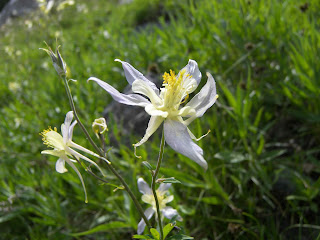
So goes a local bumper sticker; though probably directed towards skiers, the saying is apt for climbers as well. The climbing draw here is alpine climbing and comes with all the obstacles and hazards that alpine climbing involves. Long approaches, weather, route finding, and the requisite need for speed and efficiency are all part of the allure of alpine climbing.
The obstacles are somewhat tempered by the accessibility and compactness of the Tetons themselves; hundreds of climbs packed into a portion of the range measuring four miles wide by 12 miles long. The approaches are short by Cascade standards, and bushwacking generally means a route finding mistake in the Tetons, not a Cascadian prerequisite. And a local weatherman provides daily internet updates specifically for the mountain locales.
With all these moderations to the alpine realm comes the real danger; to not take these mountains seriously and to not appreciate that this is an alpine world can easily lead into, at best, objectives unmet and endless miles hiked with little to show for the effort. And that has been the story of my first few weeks in Jackson. Not a beating per se—I stayed out of the mountains with the merest threat of weather, and quickly modified my expectations based upon my—and my partner's—ability. But still, a lot of miles hiked and only a few moderate routes completed.
The Grand Teton from summit of Middle Teton; notice virga on right!

Not to complain, however! Every day has been an education, a new lesson to draw upon in the future. And simply being here is simply wonderful! The Tetons are the epitome of what a mountain range should look like. Towering mountains rise straight up out of a plain—in this case Jackson Hole, or as it was originally known, Jackson's Hole. The highest mountain in the range is the Grand Teton at 13,770 feet. The approach trail lies at 6,732 feet, requiring just over 7,000 vertical feet of hiking, scrambling, and climbing. Though I have yet to climb the Grand, it is on my list. The typical climb takes two days, though a fit climber can reasonably expect a car to car effort (i.e., not camping, just one long push). The record from the valley floor to the top and back is an unbelievable three hours and six minutes, a time which simply staggers my imagination. Disclaiming all false modesty, I am on the fast end of hikers and scramblers—but three hours? Simply incomprehensible!
Alpine climbing consists of not only a set of problems, but also of a set of joys unique to the alpine world. High among these joys are the flora and fauna found only among high mountain settings. Driving through Grand Teton National Park and the adjoining Yellowstone National Park, one can see bison, moose, elk, bears, and if one is lucky, even wolves. But only by getting out of the car and hiking up among the hills and mountains can one spy marmots and pikas and dozens of alpine wildflowers. A hike up any Teton trail is accompanied by a visual treat of color splashes of wildflowers, and an aural treat of bird cries, marmot whistles, and the pika's indescribably cute squeeze toy sound of alert.



Guide's Wall and Baxter's Pinnacle were two introductory climbs completed, along with a few days of sport climbing when the weather threatened. Open Book was the next step up in difficulty and commitment, along with a few more opportunities to learn. My partner on this climb was Nancy, on a climbing vacation from Vermont. We had difficulty in identifying the correct ridge, and only got onto the climb after two of her friends came by and gave us directions. The routefinding on the climb itself was more straightforward, but at one point Nancy became stuck, due to several factors. A party of climbers—two Exum guides, in fact—was just below her, and before I could get back down the rope to see what was going on (we were out of visual and audio range), they had helped her out. The rest of the climb went without difficulty, and we enjoyed a beautiful view of Amphitheatre Lake as we scrambled down the backside of the climb.


Yesterday (September 1st) I headed up for my first “summit” day—actually getting to the top of one of the major peaks, in this case the Middle Teton. Moving alone, I made good time and enjoyed the sheer physicality of the hike and scramble to the top. The last two thousand feet were slow—even though I have been here almost three weeks now, I am still not used to being above 10,000 feet and the air seems distinctively thinner. Though I pass a large group of hikers, I have the summit to myself. The forecast had called for 0% rain, but I spy several clouds dropping rain from great heights above the
 mountains. The precipitation evaporated before hitting the ground, however, and I later learn the term for this weather phenomenon—virga. 12,804 feet above a faraway sea, and 6,000 feet above Jackson's Hole and the trailhead, I am a mere speck amidst a conflux of mountains and clouds and horizons. But I am a happy speck, content in the moment and in this conflux that is beginning to feel a little like home.
mountains. The precipitation evaporated before hitting the ground, however, and I later learn the term for this weather phenomenon—virga. 12,804 feet above a faraway sea, and 6,000 feet above Jackson's Hole and the trailhead, I am a mere speck amidst a conflux of mountains and clouds and horizons. But I am a happy speck, content in the moment and in this conflux that is beginning to feel a little like home.


So if or when you settle, please write that novel. I will be the first one to buy a copy! Thanks for the update!
ReplyDelete